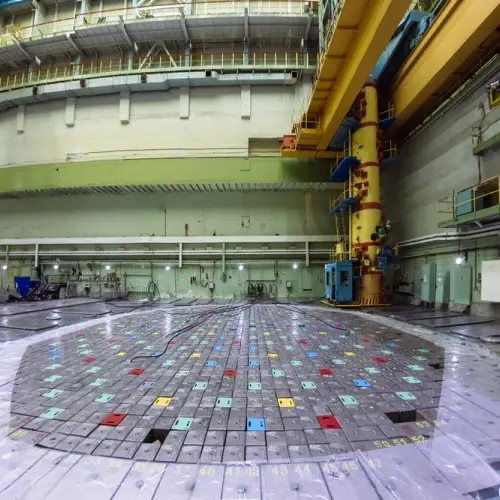
Nuclear fuel is the material used to generate nuclear energy. It is a material that can be fissioned or fused depending on whether its use is nuclear fission or nuclear fusion.
We refer to nuclear fuel both as the material (uranium, plutonium, etc.) and as a whole made from said nuclear material (fuel rods, compositions of nuclear material and the moderator or any other combination).
The most widely used nuclear fuel is uranium because it is the most suitable for nuclear fission reactors. Currently, all nuclear reactors in production for the generation of electrical energy are fission reactors. At another level, plutonium is also used as nuclear fuel.
Tritium and deuterium are light isotopes of hydrogen that are used in the nuclear fusion process. Nuclear fusion is not yet sufficiently developed to be used in nuclear power plants.
What is nuclear fuel used for?
 A nuclear power plant uses nuclear fuel to power the reactor.
A nuclear power plant uses nuclear fuel to power the reactor.
Atoms in nuclear fuel are progressively separated by the process of nuclear fission. In each of these reactions, the material is transformed into other elements, releasing thermal energy.
This heat energy is used to produce steam and drive a turbine coupled to an alternator. In this way, the nuclear power plant generates electricity.
For the reactor to operate, the mass of nuclear fuel present in the reactor reaches the so-called critical mass . Critical mass is the amount necessary to initiate a chain reaction that is self-sustaining in a stable manner.
Configuration of fuel rods in a nuclear reactor
Nuclear fuel is placed in rods inside the reactor. Rod placement provides the following advantages:
- Makes transportation easier.
- Allows alternating fuel with the neutron moderator and control rods.
- Simplifies fuel extraction at the end of the cycle.
The fissile material must be placed in a geometric arrangement that maximizes the efficiency of the chain reaction. This arrangement must take into account the need to leave sufficient space for inserting the neutron moderator.
During the design phase of a nuclear reactor, space must also be allowed for control rods and diagnostic devices.
In theory, the ideal shape would be spherical; however, a cylindrical shape is used, obtained by combining a large number of bars.
Nuclear fuel cycle
 The nuclear fuel cycle is the set of operations necessary for the production of fuel for use in nuclear power plants. The operations of the cycle also include the subsequent treatment of spent fuel.
The nuclear fuel cycle is the set of operations necessary for the production of fuel for use in nuclear power plants. The operations of the cycle also include the subsequent treatment of spent fuel.
In the case of uranium, the closed cycle includes:
- Mining to extract natural uranium.
- Production of uranium concentrates.
- Obtaining enriched uranium (uranium enrichment).
- Manufacturing of fuel elements.
- The use of fuel in the reactor.
- The reprocessing of irradiated fuel elements to recover the remaining uranium and the plutonium produced.
These tasks can be carried out by a national or international company with the proper quality control.
Nuclear fuel depletion and replacement
Unlike traditional fuels (e.g. fossil fuels), fuel consumption in a nuclear reactor is very slow. Once loaded into the reactor, it typically lasts for years.
On the other hand, refueling operations are considerably more complex.
Unlike other types of fuel, the reaction products (so-called slag) do not disperse. These products remain mainly within the rods themselves or immediately adjacent elements.
Over time, fuel rods become increasingly poor in fissile material. When the rods reach the point where it is no longer efficient to exploit them, they must be replaced.
Depending on the geometry of the reactor, it may happen that one part of the fuel is depleted faster than other parts: usually the central part is depleted faster than the outer part. The rod configuration is useful in this case because it allows the replacement of only the most depleted parts.
The spent rods, as well as the material in the immediate vicinity, have become highly radioactive due to the presence of fission products generated by the reactions, as well as other material that may be activated during the neutron capture process or as a result of other similar processes.
The removal of spent rods is therefore the most complex part of nuclear reactor slag decommissioning.
Nuclear fuel safety and control
Handling nuclear fuel requires strict safety protocols due to the radioactive nature of the materials involved. During transportation, storage and handling of fuel, various measures are implemented to protect both workers and the environment from radiation.
Nuclear reactors are designed with redundant safety systems to prevent accidents. This includes the construction of robust containment vessels, efficient cooling systems, and emergency shutdown mechanisms that stop the nuclear reaction in the event of anomalies.
In addition, nuclear plants follow rigorous quality controls and operating procedures that are regularly audited by international regulatory bodies. The management of radioactive waste is also essential, with the aim of storing it safely and avoiding the release of hazardous materials into the environment.
Comparison with other fuels
 Nuclear fuel is compared to other energy sources primarily in terms of efficiency and its environmental impact.
Nuclear fuel is compared to other energy sources primarily in terms of efficiency and its environmental impact.
- Efficiency : Nuclear energy has a high energy density. A small amount of nuclear material can generate a large amount of energy, making it a very efficient source compared to fossil fuels such as coal or natural gas. This is because nuclear fission releases millions of times more energy per unit of mass than the combustion of fossil fuels.
- Emissions : Unlike fossil fuels, nuclear power does not emit greenhouse gases during its electricity generation, making it an attractive option for reducing carbon emissions. However, radioactive waste management is a major challenge. Nuclear waste is highly radioactive and must be carefully managed for thousands of years, which represents a cost and a long-term concern.
- Environmental impact : In terms of environmental impact, nuclear energy has the advantage of generating electricity in a very clean way compared to coal or gas plants, which emit large amounts of carbon dioxide and other pollutants. However, uranium mining and nuclear waste management do generate certain impacts, although they are considerably smaller compared to fossil fuels.
- Costs : Building nuclear power plants requires large initial investments, and the cost of operation and maintenance can also be high, mainly due to strict safety standards and waste management. However, once a nuclear power plant is operational, the cost of producing electricity is relatively low.
- Sustainability : Nuclear power is a low-carbon energy source and can theoretically be sustainable if resources are properly managed, although the availability of uranium and other fissile materials could limit long-term sustainability. As renewable sources such as solar and wind develop and become more competitive, nuclear power remains an option, but its role in the global energy mix could change.